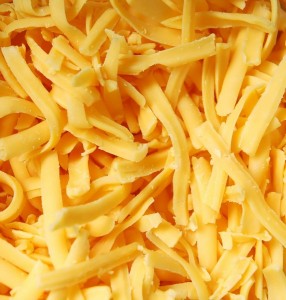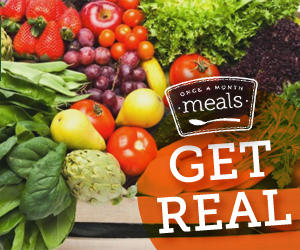**This post is part of the Get Real series. Please remember that this is meant as a learning community. We know that many of you are passionate about what you do and we want you to express that, just please do so in a way that will be an encouragement and aid to others making a transition. We want this to be a “safe space” for participants to learn. For that reason, we reserve the right to delete any comments that are not handled in this manner.
We’ve covered eggs, milk and cultured dairy so far this month. But what about those other staples in the dairy aisle? The ones that make everything just taste that much better: cheese and butter? I mean they are staples here at Once A Month Meals, with the exception of the Gluten Free Dairy Free meal plan. So what should you look for when picking these refrigerator staples?
Butter
When it comes to grass-fed versus grain-fed butter, there are quite a few differences similar to what Wardee pointed out in our milk post. For example, the vitamin content of grass-fed butter is higher. It’s a beautiful deep yellow color and is even rich to the touch as opposed to the white and waxy grain-fed butter. Grass-fed butter has a higher CLA (Conjugated Linoleic Acid) content. Although classified as a trans-fat, it’s a good and naturally occurring one. CLA has been linked to heart health and greater fat loss in the obese and overweight. And grass-fed cows have three to five times the amount of CLA as grain fed cows.
Think this special and magic butter is impossible to find? WRONG. KerryGold butter is imported from Ireland and is available at most big box grocery stores. The other option which I am seeing in more and more stores is Organic Valley – look for the green box! Your other option? Check your farmer’s markets and search for a local dairy near you that may produce pastured butter.
Cheese
If we haven’t hammered it home enough already, grass/pasture-fed dairy is the best option. Now finding pasture/grass fed cheese in your grocery store is a whole new challenge. The best way is to try and find a local producer in your area, but that is not always easy, especially for those in urban areas.
Imported cheese from Europe is the next best option, however it doesn’t come without a cost. Lastly, Tillamook cheese is made right here in the US and is widely available at most grocery stores. Their cows are pasture-raised a majority of the year weather permitting and are antibiotic and growth hormone-free. Not to mention it’s some of the tastiest cheese I’ve ever had!
Now I know especially with OAMM cooking it’s easy to buy the packaged shredded cheese for convenience and ease. However, that shredded cheese doesn’t come without a price. If you look on the label, even on the biggest organic brands, you’ll see cellulose. What’s cellulose you may ask? “Powdered cellulose: minuscule pieces of wood pulp or other plant fibers that coat the cheese and keep it from clumping by blocking out moisture.” Wood pulp? Yuck. I just want cheese. “Cellulose gives food “more water, more air, a creamy feeling in [the] mouth with less of other ingredients,” and only a very small amount is needed.” Save yourself the additive, even if it’s natural, and just buy a block of cheese. It’s the same price if not cheaper than the shredded bags. Plus it will taste better sprinkled on your favorite dishes.
June Week Three Action Item:
- This week, do another taste test in your house. Whip up a batch of your favorite pancakes or if the heat will allow, make some bread. Buy regular butter and pasture-fed butter. Then have a slice of bread with one of each and see which you prefer!
- Challenge yourself to stop buying the shredded cheeses and start shredding your own. Use the shredding tool on your food processor or grate it the old-fashioned way.
June Get Real:
Please take a moment to thank our guest authors by clicking over to their sites and/or liking them on Facebook and/or Twitter.
Sponsor: Once A Month Meals